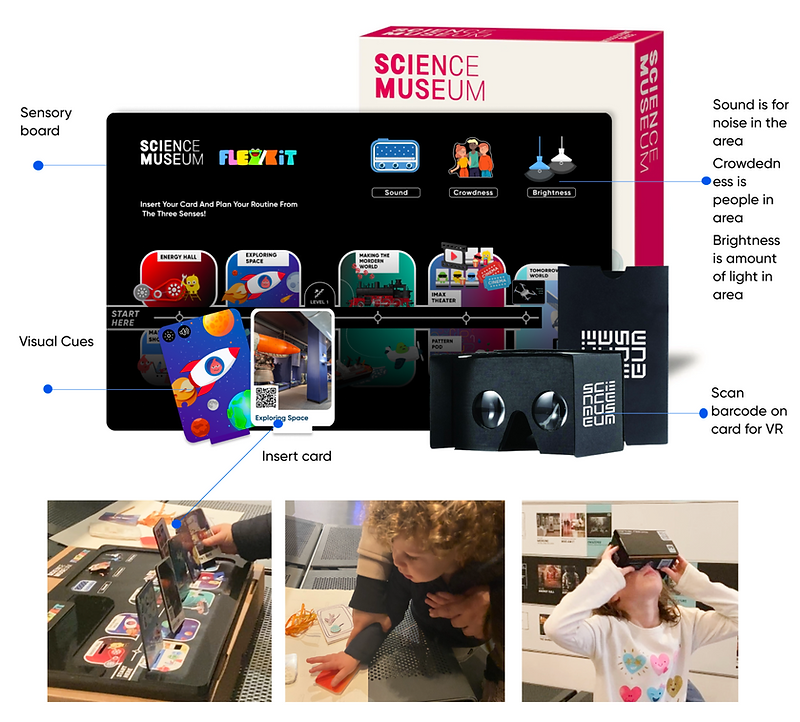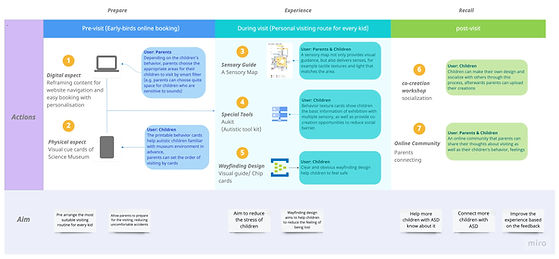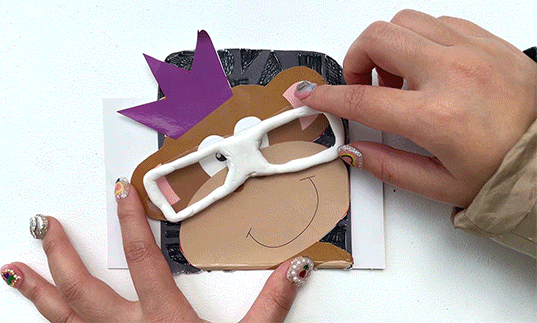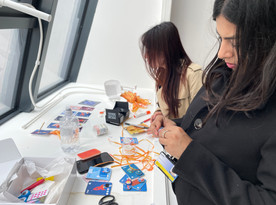
FlexiKit - An Interactive Game Toolkit
FlexiKit is an interactive game toolkit for children with Autism Spectrum Disorder for better museum visits. The aim is to provide information and guidance about the Museum's settings to individuals who are on Autism Spectrum and their families to plan their visits according to their comfort level.
This research-focused project was my final major project for my Master's degree at UAL. I worked in an academic environment in an agile way, implementing and iterating quickly to create an inclusive museum visitor experience.
See Full Process in my Blog.
Colloborator
Team
Manali
Svaney
Time
Jun.2021 - Dec.2021
My Role
Researcher
Designer
Physical Prototype
Challenge

Museum-based learning is becoming increasingly important for children. However, museums sometimes are sites of spectacle with strong lights and loud noise, which can be too overwhelming and intimidating to children with Autism Spectrum Disorder (ASD). (Gaines et al., 2016).
Goal

Video Clip - Testing at Science Museum London
Final Design
Final output:
• An Interactive Sensory Map
• Visual Cue cards
• A VR Experience of the Exhibits.

Research
Approach:
• Desk research
• On-site visiting
• Shadowing in a special education classroom
• Quantitative research (Surveys)
• In-depth semi-structured interview
Key Findings:
• Known or predictable situations are crucial for individuals with ASD so pre-visiting design is very important.
• Sensory overload may result if many stimuli occur simultaneously or if rapid transitions occur.
• Individuals with ASD have difficulty understanding intangible messages, like emotion, and body language, but tangible social cues can be helpful.
Ideation
User Journey Map
Before starting the design, I mapped out the entire museum experience and divided it into three phases: PRE-VISIT, ON-SITE, and POST-VISIT experiences.


Tangible User Interfaces &
Digital User Experience
Tangible social cues could be the bridge for people with ASD to communicate with others since individuals with ASD have difficulty understanding intangible messages, such as emotion, and body language.
I had the idea to design a toolkit that combines tangible user interfaces and digital user experience design to support children with ASD and their families.
Based on the research findings and journey map, we focused on the idea of a pre-visit toolkit to support children and their families in making museum visit plans.




Sensory Map Lo-Fi Prototype


“Designing for people with special needs should not make them feel different from others.”
Sensory Map Digital UX Experience






Visual Cue Cards Experiments
Design & Iteration
Making, Prototyping, Testing








Final Design
Final output:
• An Interactive Sensory Map
• Visual Cue Cards
• A VR Experience of the Exhibits.






Something I want to say
FlexiKit was designed for all neurodiverse children and helps those with ASD to mentally prepare and make plans before visiting museums. I would see it as an experimental design and an insight to explore the future definition of inclusive design for society. It should be used by neurodiverse children without discrimination. The key was designing for neurodiverse people rather than children with ASD to make sure those on the spectrum can feel no different.
This toolkit also has some limitations and room for improvement. From an ethical point of view, it would be unfair for those families to purchase this toolkit just because their children are on the spectrum. It should be an optional choice for all neurodiverse people, for example, it can be rented free of charge in the museum, or open for use at the museum entrance. Furthermore, as it is difficult to invite children with ASD to museums for testing during COVID, this toolkit still needs to be tested in the future with a wider range of users.
"For too long, we’ve assumed that there is a single template for human nature, which is why we diagnose most deviations as disorders. But the reality is that there are many different kinds of minds. And that is a very good thing." - Jonah Lehrer












